Choosing the Best Translation of the Bhagavad Gita
By Aimee Hughes
Published: June 4, 2018 | Last updated: February 25, 2020
KEY TAKEAWAYS
Here are five of the best handpicked English translations from several of the world’s leading spiritual authors so you can find your perfect Gita.
Source: Adistock/Dreamstime.com
The Bhagavad Gita, also known as the “Song of God,” has many translations from the ancient Sanskrit to modern day English. So much so that it may be challenging to know where to begin if you’re looking to immerse yourself in it's essential living wisdom.
Advertisement
The Gita, as it is also lovingly called, is a body of spiritual wisdom found within a larger work of ancient wisdom known as the Mahabharata, one of the largest texts known to man. The Gita was said to be spoken by Lord Krishna in a beautiful melodious manner — a rhyme that, when spoken, is harmonious and pleasing to the ear.
(For some background information to start, try Beat the Blues With Hindu's Lovable Lord Krishna.)
Advertisement
With such an intricately woven and delicate text, translations can be tricky. How do you know where to find the best one? Your copy of the Gita is one you’ll want to cherish as you study it slowly and carefully, so finding the perfect translation is essential.
Let’s take a look at some of the best translations of the Gita out there, so that you can make an educated choice when investing in your yogic and scholarly purchase.
Top 5 English Translations of the Bhagavad Gita:
1. The Accessible Translation
One of the most gorgeous translations of the Bhagavad Gita comes from the late scholar, Eknath Easwaran. Originally from Kerala in southern India, Easwaran was an English professor, meditation teacher, Hindu scholar and spiritual leader who moved to California to write and teach. His version of the Gita is one of the most revered for its accessibility and accuracy. The text reads smoothly and includes various notes, a Sanskrit glossary and colorful introductions. Easwaran also authored a treasure trove of spiritual books that you'll want to check out.
Advertisement
2. The Scholarly Translation
A more scholarly translation of the Gita comes from Georg Feuerstein, another prolific author who has made his name in the realm of yogic literature. His translation is good for those students looking for something more academic and with detailed notes. Most notably, this translation contains the entire original Sanskrit text, with both the Romanized version as well as the original Devanagari. There’s even a guide to pronunciation, a word-for-word translation and an extensive glossary. For students who are serious and want to delve deeply into the ins and outs of the Gita, Georg Feuerstein’s translation is one of the best.
3. The Easy-to-Read Translation
Another highly respected rendition of the Bhagavad Gita is the one brought to us by scholar Stephen Mitchell. Mitchell has made a name for himself as one of America’s most talented translators of spiritual literature. It’s an easy-to-read book, with poetry-like fluidity in its wording. He makes reading the ancient text enjoyable and fun. With its accessibility, this one would be a good pick for a book club or discussion group on the Bhagavad Gita. Many yogis enjoy this translation for it's accessibility without compromising any of the ancient meaning.
4. The Casual Translation
If you’re looking for a version of the Gita that’s not overly academic or large in size then you might consider “The Living Gita,” by Sri Swami Satchidananda. The notes and commentary in this translation are superb and there’s no Sanskrit to read, so if you're looking for something less bulky and academic, this may be a good fit. The author also provides commentary about his own life and spiritual journey, which is fun to read for further insights.
5. The Big, Beautiful Translation
Last but not least, if you’re looking for a version of the Gita that looks like The Bible, "The Holy Geeta" by Swami Chinmayananda is it. This is the type of heirloom you'll want resting permanently on your bedside table because it’s so pretty to look at. There’s even a ribbon attached to a bookmark inside. This beautiful hardcover book has a lot of commentary — 1,273 pages of it! If you love big, pretty sacred texts, you’ll love this one!
The Gita for You
Translations of the Bhagavad Gita are as widely varied as the yoga students that study them. We’re all different and we all have different preferences in our learning styles and capacity for knowledge. Therefore, the right translation should be one that speaks to you. It's the one that you get as much out of as you’d hope to get when studying an ancient book of profound knowledge and wisdom, which you'll hopefully soon see is quite a lot!
(Read on for Yogapedia's Interpretation of the Bhagavad Gita.)
During These Times of Stress and Uncertainty Your Doshas May Be Unbalanced.
To help you bring attention to your doshas and to identify what your predominant dosha is, we created the following quiz.
Try not to stress over every question, but simply answer based off your intuition. After all, you know yourself better than anyone else.
Written by Aimee Hughes
Aimee Hughes
Aimee is a yogi and writer who's been practicing yoga daily for more than 21 years. Since a journey to India when she was 20, the practice has been her constant companion. She loves exploring the vast and seemingly endless worlds of yoga. Aimee has also written a book titled, "The Sexy Vegan Kitchen: Culinary Adventures in Love & Sex." You can find her at her new site: https://natura.yoga
====
Confused About English Translations Of The Bhagavad Gita?
LAST UPDATED ON: SEPTEMBER 18, 2014 BY DEEPIKA BIRKS
https://www.patheos.com/blogs/gatheringnectar/2014/09/confused-about-english-translations-of-the-bhagavad-gita/
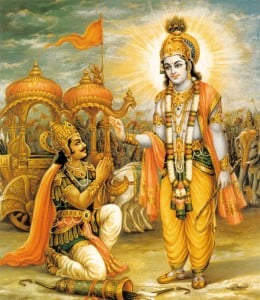 Krishna revealing the Gita to Arjuna.
Krishna revealing the Gita to Arjuna.
Translation is tricky. There is the issue of what the individual words mean, and the issue of the idea being translated. For example, you’ve probably seen signs in Spanish that say, “Prohibido fumar.” You could translate this, “smoking is prohibited” but everyone translates it, “no smoking.” Why? Because that’s how you say the exact same idea in English.
When you translate literally what the words actually mean in a dictionary, you risk a stilted rendering. When you translate freely the ideas expressed, you risk over-interpreting the text for the reader.
When I head to the bookstore, I hit the Hinduism section first. It’s usually tiny and comprised entirely of five books I’ve already read. Sometimes four of those books are translations of the Bhagavad Gita. Over the years I’ve read a dozen or so translations, some better than others. Here are a few of my favorites (for comparison, I’ve chosen chapter 4 śloka 11):
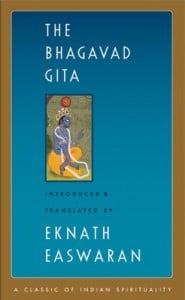 The Bhagavad Gita by Eknath Easwaran
The Bhagavad Gita by Eknath Easwaran
4.11 “As men approach me, so I receive them. All paths, Arjuna, lead to me.”
Eknath Easwaran’s translation is hand-down my absolute favorite. The English is clear and beautiful. Easwaran fell in love with English literature as a child and grew up to be an English Professor before he moved to America to teach meditation. All of his writing, whether scripture translations or otherwise, reads smoothly.
Confused About English Translations Of The Bhagavad Gita?
LAST UPDATED ON: SEPTEMBER 18, 2014 BY DEEPIKA BIRKS
https://www.patheos.com/blogs/gatheringnectar/2014/09/confused-about-english-translations-of-the-bhagavad-gita/
 Krishna revealing the Gita to Arjuna.
Krishna revealing the Gita to Arjuna.Translation is tricky. There is the issue of what the individual words mean, and the issue of the idea being translated. For example, you’ve probably seen signs in Spanish that say, “Prohibido fumar.” You could translate this, “smoking is prohibited” but everyone translates it, “no smoking.” Why? Because that’s how you say the exact same idea in English.
When you translate literally what the words actually mean in a dictionary, you risk a stilted rendering. When you translate freely the ideas expressed, you risk over-interpreting the text for the reader.
When I head to the bookstore, I hit the Hinduism section first. It’s usually tiny and comprised entirely of five books I’ve already read. Sometimes four of those books are translations of the Bhagavad Gita. Over the years I’ve read a dozen or so translations, some better than others. Here are a few of my favorites (for comparison, I’ve chosen chapter 4 śloka 11):
 The Bhagavad Gita by Eknath Easwaran
The Bhagavad Gita by Eknath Easwaran4.11 “As men approach me, so I receive them. All paths, Arjuna, lead to me.”
Eknath Easwaran’s translation is hand-down my absolute favorite. The English is clear and beautiful. Easwaran fell in love with English literature as a child and grew up to be an English Professor before he moved to America to teach meditation. All of his writing, whether scripture translations or otherwise, reads smoothly.
This translation contains neither the Sanskrit text nor a commentary. Easwaran also wrote a three volume commentary, The Bhagavad Gita for Daily Living, which does contain each verse in Devanagari script, as well as a simpler commentary called Essence of the Bhagavad Gita which does not.
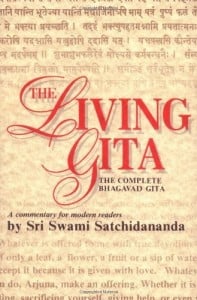 The Living Gita by Sri Swami Satchidananda
The Living Gita by Sri Swami Satchidananda
4.11 “However people sincerely call on me, I come to them and fulfill their hearts’ desires. They use many paths to reach me.”
This is a translation with the commentary interspersed. The verses are offset in bold font and numbered, and every so many verses there is commentary that fills between a few paragraphs to a few pages and often includes stories about saints or little anecdotes from Satchidananda’s life. The commentary on this verse is about a page and a half and ends, “In a way, everybody has his or her own religion. Because minds vary, each mind has its religion. Your approach is your religion.” This version contains my favorite commentary. It doesn’t contain the Sanskrit.
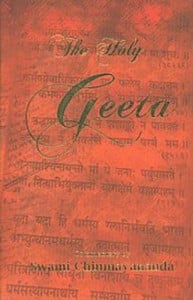 The Holy Geeta by Swami Chinmayananda
The Holy Geeta by Swami Chinmayananda
4.11 “In whatever way men approach Me, even so do I reward them; My path do men tread in all ways, O son of Pritha.”
Ever notice that bookstores have an entire aisle (or two!) filled with Bibles? They come in all different sizes and various styles of cover. I browse those aisles just to look at all the beautiful options (even though, no matter how pretty the cover, the text still doesn’t resonate with me). I’ve often wished for a copy of the Gita in a beautiful cover.
This is my prettiest Gita. It’s hard cover, with an illustration on the inside and a bookmark attached with a ribbon. Unfortunately, the paper is also the onion paper used in Bibles, so thin the text on the other side bleeds through, and after only a few pages of reading it starts to cause eye strain (for this reason, I wish it also came in ebook form, but it doesn’t).
The verses appear in the original Sanskrit, both in Devanagari and transliterated, as well as in translation (but the translation is not directly under the Sanskrit).The commentary is meaty – a direct translation of just the verses with nothing else could easily come in at 100 pages, while this version is a whopping 1273 pages. No wonder it uses such thin paper! The commentary for 4.11 reads in part, “Attachment and aversion are not the weaknesses of the Lord. He is a mass of Dynamism, the source of all activities and achievements. We are given the equipment through which we can, as we like, invoke this Infinite Mind. If we rightly invoke and carefully use the equipments, as a reward for our intelligent self-application, we can reach the Goal of our activities. If we misuse them, the very same Divine Force can be the cause of our utter disaster.”
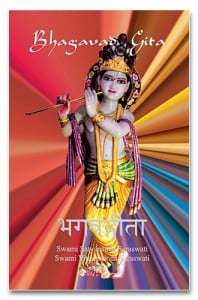 Bhagavad Gita by Swami Satyananda Saraswati
Bhagavad Gita by Swami Satyananda Saraswati
4.11 “Son of She Who Excels (Arjuna), in every way which men seek Me, in that same way I come to them, for every way that men follow is My path.”
I’ve been taking online classes from the Devi Mandir for years. Shree Maa and Swami Satyanana Saraswati have taught me how to do puja, and I’ve tuned in to their webcam on many holidays. I can’t tell you how many sentences I’ve started with, “Swamiji says…” I’ve watched thousands of hours of classes and bhajan and puja from these gurus and completed two separate courses on this text.
This translation contains the original text in Sanskrit, in large bold transliteration, and in English. The verses are sometimes awkward in English due to Swamiji’s habit of translating the meaning of names instead of the name itself. For example, in the first two ślokas, instead of “Dhritarashtra said” and “Sanjaya said,” it’s translated, “Blind Ambition said” and “He Who is Victorious Over All said.” This style of translation blends the commentary into the translation itself, which may or may not be what you want. This edition contains the Gita Mahatmya and the viniyoga – in other words, this book assumes you plan to chant the Gita in Sanskrit (or, in my case, listen along while a professional singer on my iPod chants the Gita in Sanskrit. I’m partial to Geetamritam: Melodious Rendition of the Complete Bhagavad Gita by Vanishree and Vijayalakshmi).
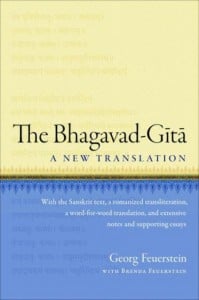
 The Living Gita by Sri Swami Satchidananda
The Living Gita by Sri Swami Satchidananda4.11 “However people sincerely call on me, I come to them and fulfill their hearts’ desires. They use many paths to reach me.”
This is a translation with the commentary interspersed. The verses are offset in bold font and numbered, and every so many verses there is commentary that fills between a few paragraphs to a few pages and often includes stories about saints or little anecdotes from Satchidananda’s life. The commentary on this verse is about a page and a half and ends, “In a way, everybody has his or her own religion. Because minds vary, each mind has its religion. Your approach is your religion.” This version contains my favorite commentary. It doesn’t contain the Sanskrit.
 The Holy Geeta by Swami Chinmayananda
The Holy Geeta by Swami Chinmayananda4.11 “In whatever way men approach Me, even so do I reward them; My path do men tread in all ways, O son of Pritha.”
Ever notice that bookstores have an entire aisle (or two!) filled with Bibles? They come in all different sizes and various styles of cover. I browse those aisles just to look at all the beautiful options (even though, no matter how pretty the cover, the text still doesn’t resonate with me). I’ve often wished for a copy of the Gita in a beautiful cover.
This is my prettiest Gita. It’s hard cover, with an illustration on the inside and a bookmark attached with a ribbon. Unfortunately, the paper is also the onion paper used in Bibles, so thin the text on the other side bleeds through, and after only a few pages of reading it starts to cause eye strain (for this reason, I wish it also came in ebook form, but it doesn’t).
The verses appear in the original Sanskrit, both in Devanagari and transliterated, as well as in translation (but the translation is not directly under the Sanskrit).The commentary is meaty – a direct translation of just the verses with nothing else could easily come in at 100 pages, while this version is a whopping 1273 pages. No wonder it uses such thin paper! The commentary for 4.11 reads in part, “Attachment and aversion are not the weaknesses of the Lord. He is a mass of Dynamism, the source of all activities and achievements. We are given the equipment through which we can, as we like, invoke this Infinite Mind. If we rightly invoke and carefully use the equipments, as a reward for our intelligent self-application, we can reach the Goal of our activities. If we misuse them, the very same Divine Force can be the cause of our utter disaster.”
 Bhagavad Gita by Swami Satyananda Saraswati
Bhagavad Gita by Swami Satyananda Saraswati4.11 “Son of She Who Excels (Arjuna), in every way which men seek Me, in that same way I come to them, for every way that men follow is My path.”
I’ve been taking online classes from the Devi Mandir for years. Shree Maa and Swami Satyanana Saraswati have taught me how to do puja, and I’ve tuned in to their webcam on many holidays. I can’t tell you how many sentences I’ve started with, “Swamiji says…” I’ve watched thousands of hours of classes and bhajan and puja from these gurus and completed two separate courses on this text.
This translation contains the original text in Sanskrit, in large bold transliteration, and in English. The verses are sometimes awkward in English due to Swamiji’s habit of translating the meaning of names instead of the name itself. For example, in the first two ślokas, instead of “Dhritarashtra said” and “Sanjaya said,” it’s translated, “Blind Ambition said” and “He Who is Victorious Over All said.” This style of translation blends the commentary into the translation itself, which may or may not be what you want. This edition contains the Gita Mahatmya and the viniyoga – in other words, this book assumes you plan to chant the Gita in Sanskrit (or, in my case, listen along while a professional singer on my iPod chants the Gita in Sanskrit. I’m partial to Geetamritam: Melodious Rendition of the Complete Bhagavad Gita by Vanishree and Vijayalakshmi).

The Bhagavad-Gita: A New Translation by Georg Feuerstein
4.11 “Just as these [yogins] resort to Me, so do I love them [in turn]. Everywhere, O son-of-Prithā, humans follow My ‘track.’” (There is a footnote for the word track that reads, “The terms vartman (‘track’) can also be rendered as ‘path.’”
This is the most scholarly translation I own. The left-hand page contains the Sanskrit in both Devanagari and transliteration, while the right-hand page contains a very literal translation, usually with several footnotes. People who are familiar with how in-depth Bible studies are conducted would be at home with this version. A section in the back contains a word-by-word literal translation if you want to check which word meant what. For 4.11 it says, “ye (plural) = who; yatha – just as; mam = to me; prapadyante = they resort; tams (tan) = them; tathaiva (tatha + eva) = thus verily, here: so; bhajami = I love; aham = I; mama = my; vartmanuvartante (varma +anuvartante) = they follow [my] track; manusyas = humans; partha = O son-of-Pritha; sarvasas = everywhere.” This is clearly not a book you’d pick up for casual reading, but I’m just nerdy enough to appreciate it.
The translation you prefer will depend on how you plan to use the text.Want a version that reads clearly in excellent prose? Try The Bhagavad Gita by Eknath Easwaran.
Want a friendly commentary that isn’t too bulky or academic? Try The Living Gita by Sri Swami Satchidananda.
Want a beautiful, heirloom-quality book? Try The Holy Geeta by Swami Chinmayananda.
Want to chant the Gita or to follow along while someone chants? Try Bhagavad Gita by Swami Satyananda Saraswati.
Want to study the text verse-by-verse in-depth and study the Sanskrit? Try The Bhagavad-Gita: A New Translation by Georg Feuerstein.
The best translation is the one you get the most out of.
===
Profile photo for Tapas Vijaya
Tapas Vijaya
study, investigate & practice the philosophies of Hinduism1y
What is the best translation of the Bhagavad Gita? Why do you think so? What are its advantages over other translations, if any?
What is your intention of reading Srimad Baghavad Gita.
This is the most holiest books that is presented to mankind.
This is the condensed subtract of the teachings of Upanishads, Puranas, Yoga sutras techniques and it is possible to be get a wide knowledge about all the teachings of humanity. Since in this book, the Lord has ventured into a great task, it may not be understood for the beginners of spiritual life.
It is for this reason, Swami Vivekananda has elaborated this teachings into four folds such as Bhakti yoga, Jnana yoga, Karma yoga and Raja yoga. If one reads this book and understands the teachings of this religion, then take up a simple the simplified version of Baghavad Gita presented by Rajaji. When the overall teachings are clear, then get into the specifics by depending on the detailed commentary by Swami Tapasyananda.
Swami Tapasyananda has taken pains to cover all the minute details of the sayings of Sri Krishna without having any inclined mind as done by Dvaitist to interrupt Baghavad Gita in the dvaitic angle and the same by the advaitins.
Swami Tapasyananda’S books are available at Sri Ramakrishna mutt centres.
55 views4 shares
===
01.12.2020
After centuries of “colonized” English translations of the Bhagavad Gita a Canadian scholar restores it to its original meaning
Published in: Languages/Linguistic curiosities, Literary translation
by Pisana Ferrari – cApStAn Ambassador to the Global Village
Hindu scholar and linguist Jeffrey Armstrong has spent the past 10 years translating and “decolonizing” the Bhagavad Gita, one of India’s most famous epic poems, written 5.000 (some say 7.000) years ago. His work was published this month with the title The Bhagavad Gita Comes Alive: A Radical Translation. The 701 verses of the Gita, written in Sanskrit, have been translated into English hundreds of times since the late 18th century. The poem recounts a dialogue between Arjuna, one of five Pandava princes, and the Hindu deity Krishna, who serves as Arjuna’s charioteer. The action of the Gita is set in the great Indian epic Mahabharata, which focuses on the interrelated families of the Pandavas and Kauravas and their struggle for control of the land of Bharat in India.
The Gita illustrates spiritual truths through its epic tale and touches on many different subjects, including self-knowledge, self-realization, discipline, sense of duty, the need to cultivate an attitude of non-attachment and detachment, reincarnation, devotion, the union of the individual with the Universe. Like all great works of literature, it can be read on many levels: metaphysical, moral, spiritual, and practical; hence its enduring appeal.
Armstrong says that the true meaning of the Gita is lost in Western translations. Christianity colonized the world and didn’t really take an interest in the cultures it wanted to take things from, he says. Christianity and colonialism are closely linked, as Protestantism and Catholicism were the state religions of the European colonial powers. Armstrong claims every English version of the Gita has the same Christian terminology: Lord, God, sin, angels, devils, soul, heaven, concepts that do not exist in Sanskrit or in Indian cultures and are totally foreign to the Gita’s world view
Armstrong’s radical approach to translating the Gita
We found some details of Armstrong’s approach to the translation in the foreword of the book, written by Prof. Nilesh N. Oak, of the Institute of Advanced Sciences in Dartmouth, MA. Prof. Oak says Armstrong’s translation focuses on conveying the essential, innate and root meaning of each verse of the Gita. He has removed all the misleading English words of previous translations and identified, corrected and removed all “colonial” terms.
Oak also says that Armstrong made the careful choice to keep many of the original Sanskrit words within the English verse, where he felt that an English equivalent would only distort the Sanskrit meaning, or do more harm. Where necessary, he has inserted short English definitions within the verse, but for non-translatable or deeply nuanced words, he has provided in-depth definitions in a glossary.
References to the Gita in Western culture
One can find references to the Gita in some of the most famous works of American literature and philosophy, including Ralph Waldo Emerson’s poem “Brahma”, T.S. Eliot’s Four Quartets, and works by Henry David Thoreau, as well as in pop culture, e.g. songs by the Beatles. Dr. Jeffery D. Long, Professor of Religion and Asian Studies at Elizabethtown College, PA, claims that the Gita has had a profound influence also on George Lucas, the creator of “Star Wars”. “In the case of Lucas”, he says, “it is subtle, and must be teased out of a close viewing (or better yet, multiple viewings) of his films: the teachings of Yoda; the theme of detachment that runs throughout the tragic story of the rise, fall, and redemption of Anakin Skywalker; and so on”.
Long quotes one particular “Gita moment” in the Star Wars saga. The Gita, he says, is a dialogue which takes place whilst the events of the larger epic fade into the background, and the focus becomes the spiritual path. Likewise, he says, the most profound dialogue between Luke and Yoda occurs as Luke’s Starfighter sinks fully into the waters of the swamp, as the war between the rebellion and the empire rages in the space beyond. Here Yoda challenges Luke to see well beyond our normal concepts of space, time, and causation. An interesting take, no doubt!
What about “male colonisation” in translation?
We venture to draw a parallel between what Armstrong calls the “Christian colonization” of works in translation, as in the Gita, and different forms of “male-culture-oriented colonization” of translated literature. To illustrate this concept we take the example of two epic poems recently retranslated by women scholars: the first is the Old English epic poem Beowulf (by Maria Dahvana Headley); the second is the Greek classic The Odyssey (by Emily Wilson).
In her translation of Beowulf, a very “testosterone-drenched narrative”, Headley says she worked to shine a light on the motivations, actions, and desires of the poem’s female characters, as well as to clarify their identities. The translation “makes interventions in the text to grant space to its women, and a chance at agency and grace”, in a way that previous translations had not allowed, thus restoring it to its original intent.
In The Odyssey, Wilson also “scraped away the barnacle layers of centuries of masculine readings” to restore a less judgmental and more gender neutral version, more faithful to the original. Wilson says there is nothing in Homer to correspond to the “modern pseudo-moral judgments” of previous translations and that this is a clear case where “modern bias has been projected back onto antiquity”. See some concrete examples from both these works in our articles on the topic, at this link for Beowulf, and here for The Odyssey
About the author
Jeffrey Armstrong is Founder of VASA Vedic Academy of Sciences & Arts, International Speaker, Best-selling Author, Vedic Scholar, Linguist and Poet. His passion for the Sanskrit language began 50 years ago when he was a young university student practicing yoga. Read more about him at this link
Sources
“Vancouver scholar pens first decolonized English translation of ancient Indian scripture”, Tiffany Crawford, The Province, November 14, 2020
“The Bhagavad Gita Comes Alive”, Jeffrey Armstrong, Foreword
“The First Book of Yoga: The Enduring Influence of the Bhagavad Gita”, Stefanie Syman, Yoga Journal, October 12, 2018
“Hindu Themes in Western Popular Culture: A Tale of Two Georges, Part One”, Dr. Jeffery D. Long, Patreon, April 2, 2018
“Hindu Themes in Western Popular Culture: A Tale of Two Georges, Part Two”, Dr. Jeffery D. Long, Patreon, April 9, 2018
“Bhagavad Gita” Ancient History Encyclopedia
===
===
===
